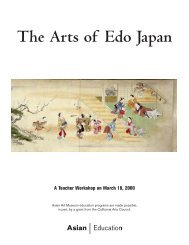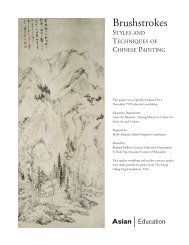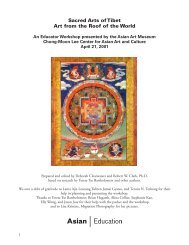Download PDF (free) - Asian Art Museum | Education
Download PDF (free) - Asian Art Museum | Education
Download PDF (free) - Asian Art Museum | Education
Create successful ePaper yourself
Turn your PDF publications into a flip-book with our unique Google optimized e-Paper software.
Following the lead of Chinese culture, women and men of all classes engaged in the<br />
traditional arts of music, painting, calligraphy, and games of skill. With their rapid<br />
accumulation of wealth, Edo townspeople also became patrons of art, creating a<br />
previously unprecedented “artistic pluralism” (Guth, p. 11). For the first time, the<br />
aristocracy no longer dictated artistic trends and production, despite attempts by<br />
the shogunate to curtail artistic consumption<br />
among its subjects. The artistic trends in Edo<br />
reflected a growth in popular culture and a<br />
demand for art with mass appeal.<br />
The shogunate built an extensive network<br />
of waterways and five major highways that<br />
connected the three major cities of Edo,<br />
Kyoto, and Osaka with smaller towns and<br />
ports, which facilitated increased travel among<br />
all classes. Besides business, pilgrimage was the<br />
most common reason for travel. Commoners<br />
made pilgrimages to sites of religious<br />
importance, such as famous Buddhist temples,<br />
ancient Shinto shrines, famous places such as<br />
Mount Fuji, etc. People often traveled under<br />
the pretense of religious pilgrimage, desiring<br />
to leave their routine life for awhile.<br />
Publishers produced various types of guides<br />
and gazetteers that catered to the public’s<br />
fascination with travel and pilgrimage. Unlike<br />
earlier travel books, which were more like works of literature, Edo period travel books<br />
were practical guides for the masses that included not only lodging information and<br />
advice on road conditions, but also historical tidbits about a place and its references<br />
in poetry. They were usually illustrated with black-and-white woodblock prints.<br />
The Yoshiwara<br />
The Yoshiwara, the licensed pleasure quarter of the city and center of social life,<br />
added to the vibrant culture of Edo. Although there were other pleasure quarters<br />
in every major city, such as Kyoto and Osaka, the Yoshiwara was most famous.<br />
Swinton (1996) likened the pleasure districts more to fantasy theme parks of<br />
romance and adventure, rather than the crude modern-day concept of red-light<br />
districts. A self-contained community, the Yoshiwara was deliberately located away<br />
from the main section of Edo, as a conscious effort by the shogunate to prevent it<br />
from “polluting” the rest of the city. It housed approximately ten thousand people<br />
(Smith, p. 30), and was packed with brothels, Kabuki theaters, teahouses, restaurants,<br />
bathhouses, and puppet shows. People of all classes walked the streets, including<br />
samurai, street performers, beggars, gamblers, sumo wrestlers, courtesans, merchants,<br />
artisans, and travelers who had come from far away to visit this tourist destination.<br />
Whereas the rest of Edo was segregated among the classes, within the Yoshiwara,<br />
Japanese of all classes could socialize more or less as equals.<br />
<strong>Asian</strong> <strong>Art</strong> <strong>Museum</strong><br />
6<br />
<strong>Education</strong> Department
















